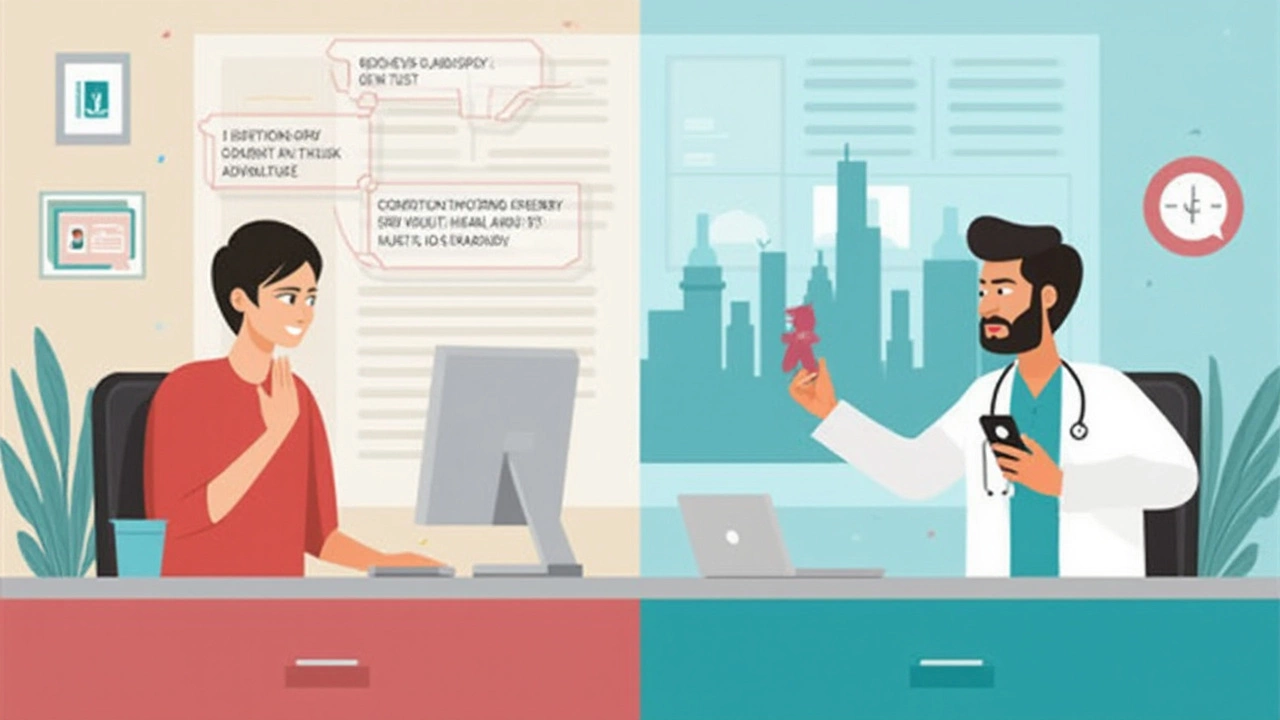You’ve probably seen ads for apps promising meds after a quick video chat, and you might wonder—is this even legit? Virtual doctors can definitely write prescriptions in most places as of 2025, but there’s more to it than hopping on a call and picking up pills. The process has rules to protect you from getting the wrong medication or falling into shady online traps.
If you need a quick refill for birth control or allergy medicine, online visits can save time and hassle. But don’t expect a virtual doctor to hand out powerful painkillers or ADHD meds without strict checks—laws and guidelines make those much harder to get online. It all depends on where you live, what you need, and your medical history.
The real trick is making sure the virtual clinic is using real, board-certified doctors. Skip any website that feels sketchy, won’t video call, or pushes strange “miracle cures.” Pay attention to which medications can actually be prescribed online and when you’ll need to show up in person or send in supporting medical info. There’s a line between legit medical care and risky shortcuts. Let’s break down where that line sits right now.
- How Online Prescriptions Work
- What Virtual Doctors Can and Cannot Prescribe
- Legal and Safety Checks
- Tips for Safe Online Prescriptions
- Future Trends in Online Prescribing
How Online Prescriptions Work
It’s honestly way simpler than most people think. The whole idea of online doctor consultation is to get you seen (virtually) without sitting in a waiting room. If you need a virtual doctor prescription, you usually start by signing up with a trusted telemedicine service or a pharmacy’s website. Then comes your actual consult, which could be a video call, a phone call, or sometimes just a secure online questionnaire for simple refills.
Here’s how the process usually goes:
- Pick a telemedicine platform: Make sure the service uses real, licensed doctors. Look for ones with clear reviews and transparent pricing.
- Book your online visit: You pick a time that works. For most everyday needs, you’ll have a live video or phone session with a doctor. Sometimes, for straightforward refills, you just fill out a medical history form.
- Doctor review: The doctor looks over your answers or talks with you live. They’ll check your symptoms, medical history, and decide if you actually need a prescription—or if something in-person is safer.
- Prescription sent: If it’s safe, the doctor electronically sends a prescription straight to your local pharmacy, or, with some platforms, to a pharmacy that delivers to your door.
This process isn’t some wild experimental tech; it’s now fully mainstream. In 2024, over 60% of US adults used some kind of telehealth at least once. Most say convenience and quick turnaround is the reason. Here’s what happened the last time lots of folks tried online prescriptions:
| Year | % US Adults Using Telehealth | Top Prescription Types |
|---|---|---|
| 2022 | 48% | Birth control, allergies, antibiotics |
| 2023 | 55% | Same, plus antidepressants & cholesterol |
| 2024 | 62% | Anxiety, asthma, and skin meds |
The whole thing is pretty similar to a real-life doctor’s visit—just faster. There are a few catches, though: not every condition or medication can be handled virtually. Still, if you need help with everyday stuff, or know what you need based on your medical history, telemedicine makes the process easier than ever.
What Virtual Doctors Can and Cannot Prescribe
So, can virtual doctors prescribe whatever you want? Not quite. Let’s get specific so you know what’s actually possible during an online doctor consultation—and what’s just not happening digitally, at least in 2025.
Here are common meds you can score online, assuming your virtual visit checks out and the doctor feels it’s safe:
- Regular birth control pills and patches
- Allergy meds (like Claritin, Zyrtec, nasal sprays)
- Simple antibiotics (for things like sinus infections or UTIs, based on symptoms)
- Some antidepressants and anti-anxiety meds (if your situation is pretty clear and not high-risk)
- Refills for blood pressure or cholesterol meds (if you’ve been on them a while and need a quick check-in)
- Dermatology stuff—think acne creams, eczema ointments, or some hair loss treatments
Sounds handy, right? But plenty of meds are still a no-go for virtual prescribing—either because of tough laws, safety concerns, or both. Here’s what you usually can’t get through a regular telemedicine app:
- Controlled substances: Think opioids, strong painkillers, ADHD meds like Adderall or Ritalin, and some sleep meds. These are heavily regulated, and most states ban remote prescriptions for these unless you’ve had a recent in-person exam—thanks to the Ryan Haight Act and similar laws.
- Complex psychiatric drugs: Meds like lithium or clozapine are rarely prescribed online because you need close follow-up and lab tests for safety.
- Cancer treatments, HIV meds, or injectables: These need physical exams and lab results. Any decent platform won’t promise them without a real-world doctor visit.
Here’s a quick snapshot (as of 2025) of how typical meds break down for online prescriptions:
| Medication Type | Online Prescription? |
|---|---|
| Antibiotics (common) | Usually Yes |
| Birth Control | Yes |
| Opioids / Strong Painkillers | No |
| ADHD Stimulants | No / Rarely |
| Blood Pressure Meds | Often Yes (refills) |
| Acne/ Eczema Creams | Yes |
| Cancer Meds | No |
There’s another twist: what’s allowed depends a lot on your state or country. For example, some US states let telehealth doctors prescribe more than others, and during major health crises (like the pandemic), rules get tweaked. Always double-check what your state allows before booking a call, so you don’t waste money or time expecting something the system literally won’t let your doc send to the pharmacy.
The key takeaway? Telemedicine is super convenient for mild and common stuff—think refills and minor sicknesses. But for anything serious, high-risk, or tightly regulated, you’ll be headed into a real clinic, not just logging into an app.

Legal and Safety Checks
This is where things get serious. Not every online doctor or telemedicine site follows the same rules, and the laws around virtual doctors and online prescriptions can change depending on what country or state you’re in.
In the U.S., for example, federal law (the Ryan Haight Online Pharmacy Consumer Protection Act) says a real doctor-patient relationship is required before most prescriptions can be sent off to a pharmacy. That means you’ll usually need a live video chat, not just a quick text message. Some platforms use board-certified doctors who are licensed in your state, while others try to bend the rules. Always double-check your provider’s credentials.
Some medications—especially controlled substances, like opioids or certain ADHD drugs—are rarely or never prescribed through telemedicine. After emergency COVID-19 rules started to relax in 2023, you need an in-person exam to get most controlled substances, and online providers who ignore this could put your health at risk.
When you do a virtual visit, real clinics will ask for your ID and full medical history before writing any online prescription. They should also check what other medicines you’re already using, so you don’t end up with a bad drug interaction. If these steps get skipped, that’s a red flag.
- Never use a telemedicine site that skips video or phone chats for new prescriptions.
- Always check the provider’s state license. It’s usually listed somewhere on their website.
- Look for reviews and see if the platform is tied to any major health systems or hospitals.
- If a site promises easy access to controlled drugs, run the other way. That’s a major safety risk.
Here’s a quick breakdown of what most online doctor consultations check before writing a prescription:
| Check | Why It Matters |
|---|---|
| Identity Verification | Prevents fraud and ensures the prescription goes to the right person. |
| Medical History Review | Flags allergies, ongoing conditions, and past meds to avoid dangerous combos. |
| Real-Time Assessment | Lets the doctor spot any red flags or symptoms you might not mention in writing. |
| State License Check | Doctor must be licensed in your state for the prescription to be valid locally. |
Bottom line: If a virtual doctor skips any safety or legal steps, move on. There are plenty of legit, efficient online options that keep you safe while making things fast and easy.
Tips for Safe Online Prescriptions
Getting a virtual doctor to write prescriptions is convenient, but you have to watch out for scams and bad advice. Here’s how to stay safe (and make sure you’re not throwing money—or your health—down the drain):
- Stick with Licensed Platforms: Only use telemedicine services that show clear info about their doctors and have real reviews. In the U.S., the doctor needs to be licensed in your state. Most legit services will ask for your ID and pharmacy info before you even book.
- Look for a Real Consultation: A legit online doctor consultation will almost always involve a video or phone chat where you answer questions about your symptoms, meds you’re already taking, and your allergies. If they just want your credit card and don’t bother to check if the prescription is right for you, run.
- Check the Prescribing Rules: Not every medicine can be prescribed online. Things like antibiotics or birth control are common, but most states don’t allow online prescriptions for controlled substances (like strong painkillers or ADHD meds) without a prior in-person visit.
- Watch Out for “Miracle Cures”: If a site is pushing some weird remedy or offers to prescribe stuff without real questions, skip it. Only trust prescriptions that look like what you'd get from your regular provider.
- Verify the Pharmacy: Get your medicine from a real, licensed pharmacy. If the site sends you pills directly instead of a prescription you can fill at any pharmacy, check that they’re registered (in the US, look for .pharmacy URLs or check NABP's list).
- Compare Costs and Insurance: Sometimes, online visits are cheaper than urgent care, but not always. Some health insurance plans now cover a virtual doctor visit, so it’s worth checking instead of paying out of pocket.
If you’re worried, don’t be shy—ask the online clinic about their doctors, where your prescription can be filled, or even how your medical info is kept private. Good platforms will answer (and not dodge) those questions. According to a 2024 survey from the American Telemedicine Association, 82% of users said they read the website’s FAQ or help section before booking—people who did felt much less worried about scams or prescription errors.
| What to Check | Why It Matters |
|---|---|
| Doctor credentials visible | Shows it’s a real provider, not a bot or scam. |
| Platform is licensed in your state/country | Ensures legal prescriptions and protection for you. |
| Clear privacy policy | Keeps your medical data safe. |
| Prescription sent to licensed pharmacy | Prevents fake or unsafe meds. |
Pill mills and shady websites give the whole idea of digital health a bad reputation, but being a little suspicious isn’t a bad thing. Use your common sense and don’t trust anything that seems too easy or sounds off. If you follow these tips, you’ll get the perks of online medicine without any of the big risks.

Future Trends in Online Prescribing
The world of online prescriptions is moving fast—maybe faster than most people realize. Hospitals, clinics, and insurance companies are pushing hard for telemedicine, and the tech is only getting smarter. More apps now connect you not just to virtual doctors, but to pharmacies that can deliver your meds in hours, sometimes even by drone if you live in bigger cities.
One big shift: doctors are using AI tools to figure out drug interactions or double-check your health info during online doctor consultation sessions. Some apps can pull your medical history (with your OK) right into the chat, helping the doctor spot red flags before writing a script. In the past year, more platforms started using secure digital ID checks to verify you’re really you—no more faking symptoms under a fake name.
Here’s what else is coming down the pipeline:
- Wider range of medications: Expect to see more conditions treated online—FDA trials are running right now for things like asthma and diabetes care by telehealth.
- ePrescriptions linked to health records: Prescriptions from telemedicine visits will go straight into national health databases, making it way easier to avoid double-dosing or mixing meds in dangerous ways.
- Better insurance coverage: Insurers in the US and EU are starting to cover telemedicine visits and meds at the same rates as in-person care, making it more affordable for a lot of people.
- Smarter prescription safety: Big data lets systems flag suspicious refill requests or "doctor shopping" in real time.
| Year | Online Prescriptions Issued (Millions) |
|---|---|
| 2022 | 13 |
| 2023 | 22 |
| 2024 | 30 |
| 2025 (projected) | 41 |
There’s still a gap—some countries are tight on rules, especially around mental health meds or addictive drugs. But the trend is clear: virtual doctors and online pharmacies are not slowing down. Smart use means easier access, quicker care, and safer prescriptions—as long as the tech and the doctors keep doing things by the book.




